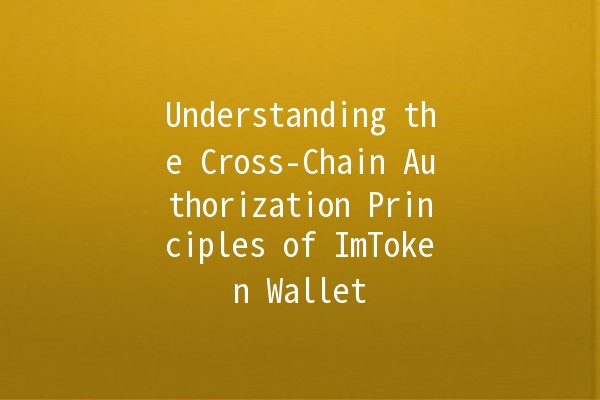In the rapidly evolving world of blockchain technology and cryptocurrencies, ensuring smooth operations across different chains is crucial. The emergence of crosschain capabilities has been a gamechanger, and platforms like the ImToken wallet are at the forefront of this development. In this article, we delve deep into the principles of crosschain authorization used by ImToken wallet, providing insights that can enhance user engagement and understanding.

ImToken is a popular digital wallet that supports multiple cryptocurrencies and allows users to manage their assets in a secure environment. One of its standout features is crosschain support, which enables transactions between different blockchain networks. This functionality is essential for users who want to interact with various decentralized applications (dApps) and manage assets across different platforms seamlessly.
As cryptocurrencies and blockchain networks proliferate, users often find themselves needing to exchange assets or interact with applications built on different chains. Crosschain functionality addresses this challenge by allowing users to access various ecosystems without requiring multiple wallets or excessive hassle.
The ImToken wallet employs several mechanisms to facilitate crosschain authorization, ensuring secure and efficient transactions. Let’s explore the principles behind these mechanisms:
Smart contracts are selfexecuting contracts with the terms of the agreement directly written into code. They play a critical role in the crosschain functionality of ImToken by:
Automating Transactions: Smart contracts eliminate the need for intermediaries, allowing for faster and more reliable transactions.
Implementing Trust: As smart contracts are immutable, they provide a trustworthy mechanism for executing crosschain transactions without requiring a third party.
Example: When a user wants to swap tokens from Ethereum to Binance Smart Chain (BSC), a smart contract automatically locks the Ethereum tokens and issues corresponding tokens on the BSC network.
HTLCs are often used in crosschain exchanges to ensure security. The key characteristics include:
Conditional Payments: Funds are locked in a contract and only released if certain conditions are met within a specified time frame.
Enhanced Security: In the event that the conditions are not met, the funds are automatically returned to the sender.
Example: Suppose Alice wants to exchange her Bitcoin for Ethereum. An HTLC would lock the Bitcoin, and the Ethereum would only be released to her if she can provide proof of receiving the Bitcoin transaction within the agreed time.
Relayers are crucial components of crosschain communication. They enable the transfer of information between blockchains by:
Facilitating Data Exchange: Relayers carry information about transactions on one chain to another chain, allowing for the proper execution of crosschain actions.
Enabling Interoperability: They help different blockchain networks communicate, further bridging the gap between isolated ecosystems.
Example: If a user wishes to perform a trade between Bitcoin and an ERC20 token, a relayer builds the transaction details on both chains, ensuring that the transfer is executed efficiently.
Atomic swaps enable users to exchange cryptocurrencies directly between parties without thirdparty involvement. This technique adds another layer of security to crosschain transactions by:
Ensuring Simultaneous Exchange: Both parties must fulfill their obligations for the transaction to occur, which reduces the risk of fraud.
Removing Intermediaries: This technology allows users to trade directly, thereby eliminating the need for centralized exchanges.
Example: If Bob and Charlie want to swap Bitcoin and Litecoin, the atomic swap protocol ensures that neither gets their respective asset until both parties fulfill the transaction requirements.
ImToken also collaborates with various DeFi protocols to broaden crosschain authorization capabilities by:
Providing Liquidity Pools: Users can contribute to liquidity pools that facilitate crosschain trading and earn rewards.
Supporting Yield Farming: Users can leverage their assets across different chains to maximize their returns, enhancing engagement within the ecosystem.
Example: A user can deposit their tokens into a liquidity pool that operates across Ethereum and Polygon, allowing them to earn a yield on their assets while participating in crosschain transactions.
To make the most of ImToken's crosschain functionalities, apply the following techniques:
By utilizing the crosschain features of ImToken, you can diversify your crypto holdings across multiple platforms. This approach not only reduces risk but also allows you to take advantage of various market opportunities.
Engage with decentralized applications built on different chains. By exploring various dApps available through ImToken, you can unlock new functionalities and investment opportunities.
Take part in liquidity mining programs found in DeFi platforms integrated with ImToken. This strategy can help increase your returns while supporting crosschain transactions.
Regularly updating your knowledge on cryptocurrency market trends and developments in the crosschain space will enable you to make informed decisions about your investments.
Always utilize the security features provided by ImToken, such as twofactor authentication and biometric locks, to ensure that your crosschain activities remain safe and secure.
Using ImToken for crosschain transactions provides users with enhanced liquidity, greater control over their assets, and the ability to participate in multiple blockchain ecosystems. Its userfriendly interface and robust security measures further support safe transaction practices across various chains.
ImToken employs advanced technologies such as smart contracts and HTLCs to ensure the security of crosschain transactions. Additionally, the wallet uses multilayered encryption methods to protect users' private keys and sensitive information.
Yes, ImToken allows users to perform crosschain swaps directly through the wallet without requiring a centralized exchange. The wallet integrates various protocols that facilitate seamless crosschain exchanges.
ImToken supports several popular blockchain networks, including Ethereum, Binance Smart Chain, and TRON, among others. This broad support allows users to engage in diverse crosschain activities.
Yes, users may incur transaction fees when conducting crosschain transactions. These fees are typically based on network congestion and gas costs on the respective blockchains involved.
To maximize the benefits, consistently engage with various dApps, participate in liquidity mining and staking opportunities, and diversify your portfolio across different chains. Additionally, staying informed about market trends will help you make better investment decisions.
Through understanding ImToken's crosschain authorization principles, users can unlock the full potential of their cryptocurrency assets while enjoying seamless interactions with various blockchain ecosystems. This holistic approach not only enhances security but also fosters a vibrant decentralized financial landscape.